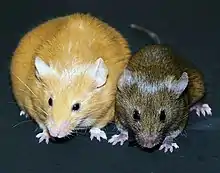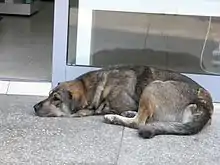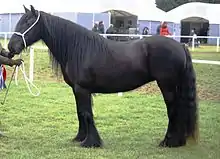Agouti coloration genetics
The agouti gene (ASIP) is responsible for variations in color in many species. Agouti works with extension to regulate the color of melanin which is produced in hairs. The agouti protein causes red to yellow pheomelanin to be produced, while the competing molecule α-MSH signals production of brown to black eumelanin. In wildtype mice, alternating cycles of agouti and α-MSH production cause agouti coloration. Each hair has bands of yellow which grew during agouti production, and black which grew during α-MSH production. Wildtype mice also have light-colored bellies. The hairs there are a creamy color the whole length because the agouti protein was produced the whole time the hairs were growing.[1][2]

In mice and other species, loss of function mutations generally cause a darker color, while gain of function mutations cause a yellower coat.[3]
Mice

As of 1979, there were 17 known alleles of agouti in mice.[4]
- Lethal yellow Ay causes yellow coloration and obesity. It is dominant to all other alleles in the series. When homozygous, it is lethal early in development.[4]
- Viable yellow Avy looks similar to lethal yellow and also causes obesity, but is not lethal when homozygous. Homozygous viable yellow mice can be variable in color from clear yellow through mottled black and yellow to a darker color similar to the agouti color.[4]
- Intermediate yellow aiy causes a mottled yellow coloration, which like viable yellow can sometimes resemble agouti.[4]
- Sienna yellow Asy heterozygotes are a dark yellow, while homozygotes are generally a clearer yellow.[4]
- White-bellied agouti AW mice have agouti coloration, with hairs that are black at the tips, then yellow, then black again, and white to tan bellies.[4]
- Agouti A looks like AW but the belly is dark like the back.[4]
- Black and tan at causes a black back with a tan belly. A/at heterozygotes look like AW mice.[4]
- Nonagouti a mice are almost completely black, with only a few yellow hairs around the ears and the genitals.[4]
- Extreme nonagouti ae mice are fully black, and is recessive to all other alleles in the series.[4]
This is not a complete list of mouse agouti alleles.
Lethal yellow and viable yellow cause obesity, features of type II diabetes, and a higher likelihood of tumors.[2] In normal mice Agouti is only expressed in the skin during hair growth, but these dominant yellow mutations cause it to be expressed in other tissues including liver, muscle, and fat.[5] The mahogany locus interacts with Agouti and a mutation there can override the pigmentation and body weight effects of lethal yellow.[6]
The mouse agouti gene is found on chromosome 2.[2]
Dogs

In dogs, the agouti gene is associated with various coat colors and patterns.[7]
The alleles at the A locus are related to the production of agouti-signaling protein (ASIP) and determine whether an animal expresses an agouti appearance and, by controlling the distribution of pigment in individual hairs, what type of agouti. There are four known alleles that occur at the A locus:
- Ay = Fawn or sable (tan with black whiskers and varying amounts of black-tipped and/or all-black hairs dispersed throughout) - fawn typically referring to dogs with clearer tan and sable to those with more black shading
- aw = Wild-type agouti (each hair with 3-6 bands alternating black and tan) - also called wolf sable
- at = Tan point (black with tan patches on the face and underside) - including saddle tan (tan with a black saddle or blanket) [8][9]
- a = Recessive black (black, inhibition of phaeomelanin)
- ayt = Recombinant fawn (expresses a varied phenotype depending on the breed) has been identified in numerous Tibetan Spaniels and individuals in other breeds, including the Dingo. Its hierarchical position is not yet understood.[10][11][12]
Most texts suggest that the dominance hierarchy for the A locus alleles appears to be as follows: Ay > aw > at > a; however, research suggests the existence of pairwise dominance/recessiveness relationships in different families and not the existence of a single hierarchy in one family.[13]
- Ay is incompletely dominant to at, so that heterozygous individuals have more black sabling, especially as puppies and Ayat can resemble the awaw phenotype. Other genes also affect how much black is in the coat.
- aw is the only allele present in many Nordic spitzes, and is not present in most other breeds.
- at includes tan point and saddle tan, both of which look tan point at birth. Modifier genes in saddle tan puppies cause a gradual reduction of the black area until the saddle tan pattern is achieved.
- a is only present in a handful of breeds. Most black dogs are black due to a K locus allele.
Cats
The dominant, wild-type A allows hairs to be banded with black and red (revealing the underlying tabby pattern), while the recessive non-agouti or "hypermelanistic" allele, a, causes black pigment production throughout the growth cycle of the hair.[14] Thus, the non-agouti genotype (aa) masks or hides the tabby pattern, although sometimes a suggestion of the underlying pattern can be seen (called "ghost striping"), especially in kittens. The sex-linked orange coloration is epistatic over agouti, and prevents the production of black pigment.
| Allele | Symbol | Image | Description | Mutation |
|---|---|---|---|---|
| Agouti | A |  |
Tabby pattern thanks to a functional agouti gene. | Wildtype |
| Nonagouti | a | .jpg.webp) |
Black, which lacks a functional agouti gene and so cannot signal MC1R to produce red pigment. | A 2 base pair frameshift deletion thought to cause a complete loss of function[15][16] |
Horses
In normal horses, ASIP restricts the production of eumelanin to the "points": the legs, mane, tail, ear edges, etc.[17] In 2001, researchers discovered a recessive mutation on ASIP that, when homozygous, left the horse without any functional ASIP. As a result, horses capable of producing true black pigment had uniformly black coats.[18] The dominant, wildtype allele producing bay is symbolized as A, while the recessive allele producing black is symbolized as a. Extension is epistatic over agouti and will cause chestnut coloration regardless of what agouti alleles are present.
A hypothesized third option, At, might restrict black pigment to a black-and-tan pattern called seal brown.[19] This allele would be recessive to A and dominant to a, such that horses with the genotype A/At appear bay, while At/At and At/a horses are seal brown in the presence of a dominant Extension allele E. One genetics testing lab began offering a test for At,[19] but it was later found to be inaccurate and is no longer offered.
| Allele | Symbol | Image | Description | Mutation |
|---|---|---|---|---|
| Wild bay | A+ |  |
Wild bay pattern, like bay but the black does not extend so far up the legs | Hypothesized |
| Bay | A |  |
Bay pattern due to a functional agouti gene. The body is red while the "points", the mane, tail, and lower legs, are black. | Wildtype |
| Seal brown | at |  |
Seal brown color, mostly black but with some red on the flanks, muzzle, and around the eyes | Hypothesized |
| Nonagouti black | a |  |
Black horses produce black pigment in the entire coat because they lack a functional Agouti protein. | An 11 base pair frameshift deletion in exon 2[18] |
History
The cause behind the various shades of bay, particularly the genetic factors responsible for wild bay and seal brown, have been contested for over 50 years. In 1951, zoologist Miguel Odriozola published "A los colores del caballo" in which he suggested four possible alleles for the "A" gene, A+, A, At, and a, in order of most dominant to least.[20]
This was accepted until the 1990s, when a new theory became popular.[21] The new theory suggested that shades of bay were caused by many different genes, some which lightened the coat, some which darkened it. This theory also suggested that seal brown horses were black horses with a trait called pangare. Pangaré is an ancestral trait also called "mealy", which outlines the soft or communicative parts of the horse in buff tan.
The combination of black and pangaré was dismissed as the cause of brown in 2001, when a French research team published Mutations in the agouti (ASIP), the extension (MC1R), and the brown (TYRP1) loci and their association to coat color phenotypes in horses (Equus caballus). This study used a DNA test to identify the recessive a allele on the Agouti locus, and found that none of the horses fitting the phenotype of seal brown were homozygous for the a allele.[18]
Since 2001, the mechanisms of the variations within the "bay" category remain unclear. Ongoing research suggests that Odriozola's theories may have been correct,[22] evidenced by a parallel condition in mice. Mice have several alleles at the Agouti locus, including At which produces black-and-tan.[23]
Donkeys
Most donkeys have creamy to gray-white areas on the belly and around the muzzle and eyes, called light points or pangare. However, a recessive variant of agouti causes those areas to be the same color as the body in a pattern called no light points or NLP, which is similar to recessive black in other mammals. This allele can be found in Norman donkeys and American miniature donkeys.[24]
| Allele | Symbol | Image | Description | Mutation |
|---|---|---|---|---|
| Light points | A |  |
A gray dun donkey with a white belly and white around the muzzle | Wildtype |
| No light points | anlp |  |
A gray dun donkey with no white areas | A single nucleotide polymorphism predicted to be deleterious to protein function[24] |
Rabbits
In rabbits, the wildtype is agouti with a light belly, and a recessive non-agouti allele causes a black coat. A third allele, possibly a mutation to a regulator or promoter region, is thought to cause black and tan color. The nonagouti allele is estimated to have first appeared before 1700.[3]
Agouti is linked to the wideband gene, with about a 30% crossover rate.[25]
Like white bellied agouti mice, rabbits with wildtype agouti produce transcripts with different untranslated 5' ends that have different dorsal and ventral expression. The 1A exon is only expressed in the belly region and may be responsible for the lighter color there.[3]
| Allele | Symbol | Image | Description | Mutation |
|---|---|---|---|---|
| Agouti | A | _04.jpg.webp) |
Chestnut, sometimes called agouti. Hairs are banded black and yellow, and the belly is light. This resembles the mouse's light bellied agouti. | Wildtype |
| Black and tan | at |  |
Black otter, black with a white belly. Tan rabbits are all this color, but also have the wideband pattern and rufous color causing their bellies to be fiery orange. | Thought to exist from classical genetics studies, but not found molecularly. May be on a promoter or regulator of agouti. |
| Nonagouti | a |  |
Black self. All hairs are fully black. | Single base pair frameshift insertion in exon 2 causing loss of function[3] |
References
- Furumura M, Sakai C, Abdel-Malek Z, Barsh GS, Hearing VJ (August 1996). "The interaction of agouti signal protein and melanocyte stimulating hormone to regulate melanin formation in mammals". Pigment Cell Research. 9 (4): 191–203. doi:10.1111/j.1600-0749.1996.tb00109.x. PMID 8948501.
- Online Mendelian Inheritance in Man (OMIM): 600201
- Fontanesi L, Forestier L, Allain D, Scotti E, Beretti F, Deretz-Picoulet S, et al. (March 2010). "Characterization of the rabbit agouti signaling protein (ASIP) gene: transcripts and phylogenetic analyses and identification of the causative mutation of the nonagouti black coat colour". Genomics. 95 (3): 166–75. doi:10.1016/j.ygeno.2009.11.003. PMID 20004240.
- Silvers WK (1979). "The Agouti and Extension series of Alleles, Umbrous and Sable". The Jackson Laboratory. Springer Verlag. Retrieved 2019-05-11.
- Klebig ML, Wilkinson JE, Geisler JG, Woychik RP (May 1995). "Ectopic expression of the agouti gene in transgenic mice causes obesity, features of type II diabetes, and yellow fur". Proceedings of the National Academy of Sciences of the United States of America. 92 (11): 4728–32. Bibcode:1995PNAS...92.4728K. doi:10.1073/pnas.92.11.4728. PMC 41780. PMID 7761391.
- . doi:10.1038/18217. Cite journal requires
|journal=(help); Missing or empty|title=(help) - "Dog Coat Colour Genetics". www.doggenetics.co.uk. Retrieved 2017-09-25.
- Dreger DL, Schmutz SM (2011). "A SINE insertion causes the black-and-tan and saddle tan phenotypes in domestic dogs". The Journal of Heredity. 102 Suppl 1: S11-8. doi:10.1093/jhered/esr042. PMID 21846741.
- Dreger DL, Parker HG, Ostrander EA, Schmutz SM (2013). "Identification of a mutation that is associated with the saddle tan and black-and-tan phenotypes in Basset Hounds and Pembroke Welsh Corgis". The Journal of Heredity. 104 (3): 399–406. doi:10.1093/jhered/est012. PMID 23519866.
- Dayna L Dreger; et al. (May 29, 2019). "True Colors: commercially-acquired morphological genotypes reveal hidden allele variation among dog breeds, informing both trait ancestry and breed potential". PLOS ONE. 14 (10): e0223995. doi:10.1371/journal.pone.0223995. PMC 6816562. PMID 31658272. Retrieved September 23, 2019.
- Agouti Series
- Dayna L Dreger; et al. (Jul 3, 2020). "Atypical Genotypes for Canine Agouti Signaling Protein Suggest Novel Chromosomal Rearrangement". MDPI. Retrieved November 29, 2020.
- Kerns JA, Newton J, Berryere TG, Rubin EM, Cheng JF, Schmutz SM, Barsh GS (October 2004). "Characterization of the dog Agouti gene and a nonagoutimutation in German Shepherd Dogs". Mammalian Genome. 15 (10): 798–808. doi:10.1007/s00335-004-2377-1. PMID 15520882.
- Eizirik E, Yuhki N, Johnson WE, Menotti-Raymond M, Hannah SS, O'Brien SJ (March 2003). "Molecular genetics and evolution of melanism in the cat family". Current Biology. 13 (5): 448–53. doi:10.1016/S0960-9822(03)00128-3. PMID 12620197.
- Eizirik E, Yuhki N, Johnson WE, Menotti-Raymond M, Hannah SS, O'Brien SJ (2003). "Molecular genetics and evolution of melanism in the cat family". Current Biology. 13 (5): 448–53. doi:10.1016/S0960-9822(03)00128-3. PMID 12620197.
- Kaelin CB, Xu X, Hong LZ, David VA, McGowan KA, Schmidt-Küntzel A, et al. (September 2012). "Specifying and sustaining pigmentation patterns in domestic and wild cats". Science. 337 (6101): 1536–41. Bibcode:2012Sci...337.1536K. doi:10.1126/science.1220893. PMC 3709578. PMID 22997338.
- "Gene A: Distribution of Black Pigmented Hair". UC Davis Veterinary Genetics Laboratory. Retrieved 2009-05-26.
- Rieder S, Taourit S, Mariat D, Langlois B, Guérin G (June 2001). "Mutations in the agouti (ASIP), the extension (MC1R), and the brown (TYRP1) loci and their association to coat color phenotypes in horses (Equus caballus)". Mammalian Genome. 12 (6): 450–5. doi:10.1007/s003350020017. PMID 11353392.
The 11-bp deletion in ASIP exon 2 (ADEx2) alters the amino acid sequence and is believed to extend the regular termination signal by 210 bp to 612 bp. The frameshift initiated by the deletion results in a novel modified agouti-signaling-protein. ADEx2 was completely associated with horse recessive black coat color (Aa/Aa) in all horses typed so far
- "Equine Testing Services". Pet DNA Services of AZ. Archived from the original on 2009-05-22. Retrieved 2009-05-26.
- Castle WE, Singleton WR (September 1961). "The palomino horse" (PDF). Genetics. 46 (9): 1143–50. PMC 1210264. PMID 13877241. Archived (PDF) from the original on 2008-09-05.
- Kostelnik B (2007). "Starting Point". The Horse Colors Site. Archived from the original on 3 March 2008. Retrieved 2008-03-04.
- Behning L (2008-02-05). "The Base Colors". Morgan Colors. Archived from the original on 2008-05-17. Retrieved 2008-03-04.
- Hustad CM, Perry WL, Siracusa LD, Rasberry C, Cobb L, Cattanach BM, et al. (May 1995). "Molecular genetic characterization of six recessive viable alleles of the mouse agouti locus". Genetics. 140 (1): 255–65. PMC 1206552. PMID 7635290. Archived from the original on 8 September 2008.
- Abitbol M, Legrand R, Tiret L (April 2015). "A missense mutation in the agouti signaling protein gene (ASIP) is associated with the no light points coat phenotype in donkeys". Genetics, Selection, Evolution. 47: 28. doi:10.1186/s12711-015-0112-x. PMC 4389795. PMID 25887951.
- Sawin PB (1934). "Linkage of "WIDE-BAND" and "AGOUTI" genes: The Agouti Gene and a Modifier Shown to Be Situated on the Same Chromosome in the Domesticated Rabbit". Journal of Heredity. 25 (12): 477–481. doi:10.1093/oxfordjournals.jhered.a103864.